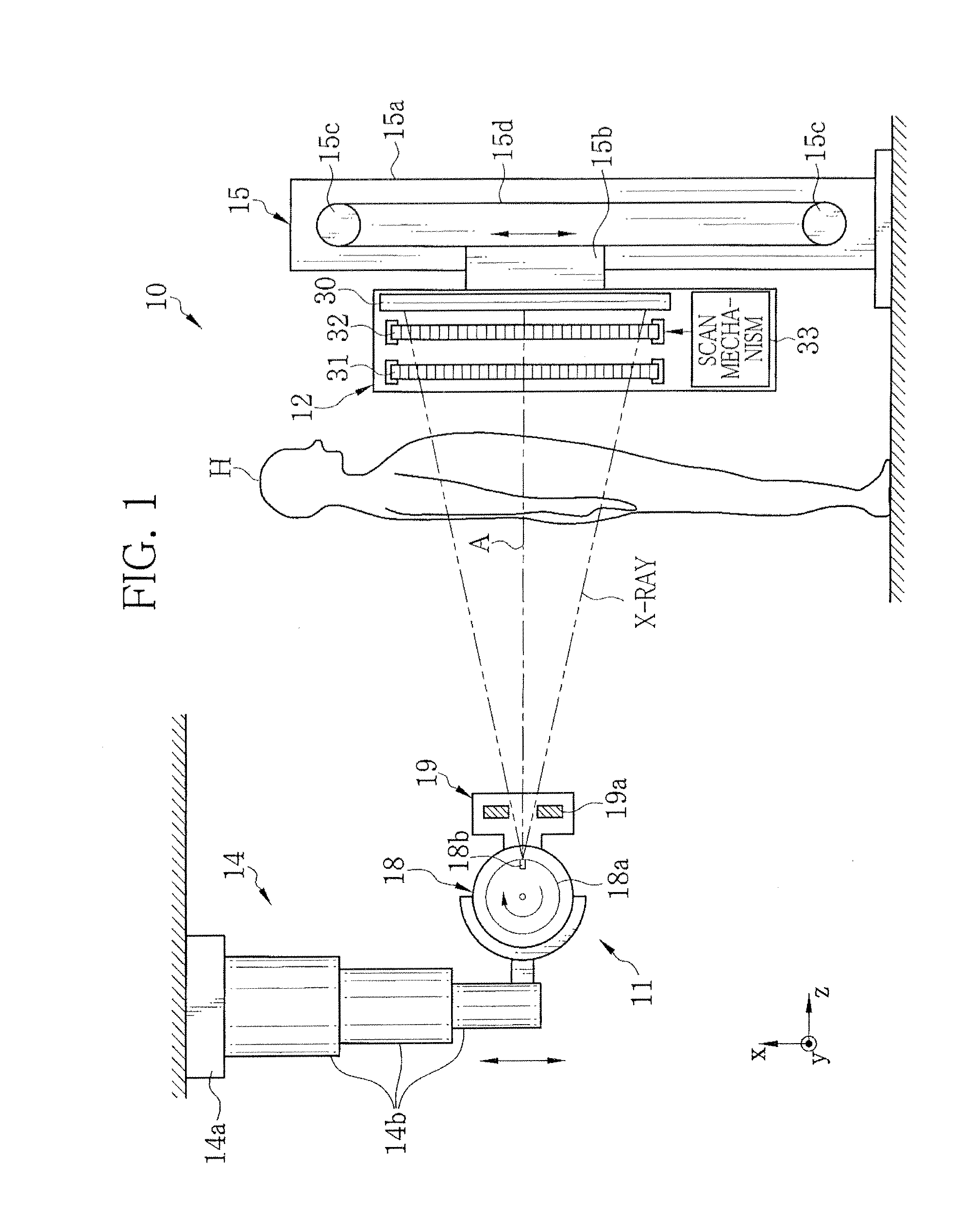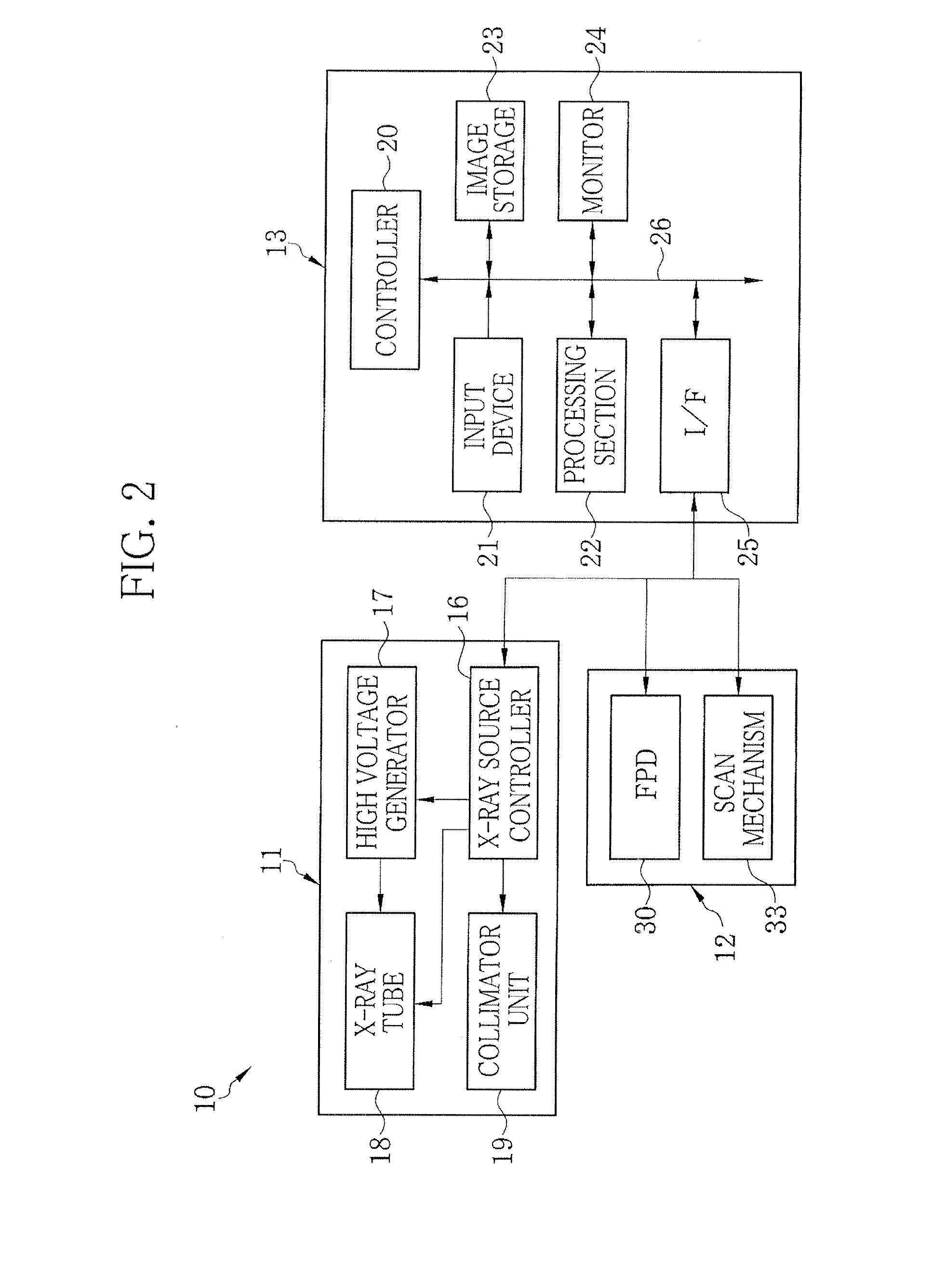Radiation imaging system
a radiation imaging and imaging system technology, applied in the field of radiation imaging systems, can solve the problems of poor image contrast, inability to obtain sufficient contrast for x-ray absorption contrast images, and inability to obtain adequate contrast for x-ray absorption contrast images, and achieve good phase contrast images
- Summary
- Abstract
- Description
- Claims
- Application Information
AI Technical Summary
Benefits of technology
Problems solved by technology
Method used
Image
Examples
first embodiment
[0077]In FIGS. 1 and 2, an X-ray imaging system 10 according to a first embodiment of the present invention is an X-ray diagnostic apparatus for capturing an image of an object (patient) H in a standing position. The X-ray imaging system 10 is composed of an X-ray source 11, an imaging unit 12, and a console 13. The X-ray source 11 irradiates the object H with X-ray. The imaging unit 12 is opposed to the X-ray source 11, and detects the X-ray passed through the object H to generate image data. The console 13 controls the exposure of the X-ray source 11 and the image capture of the imaging unit 12 based on operation of an operator. The console 13 also processes image data, obtained by the imaging unit 12, to generate a phase contrast image.
[0078]An X-ray source holder 14 holds the X-ray source 11 such that the X-ray source 11 is movable in a vertical or up-and-down direction (x direction). The X-ray source holder 14 is suspended from a ceiling. An upright stand 15, placed on a floor,...
second embodiment
[0137]FIG. 15 shows an X-ray imaging system 60 according to a second embodiment of the present invention. The X-ray imaging system 60 is an X-ray diagnostic apparatus for capturing an image of an object (patient) H in a lying position. The X-ray imaging system 60 is provided with the X-ray source 11, the imaging unit 12, and a bed or table 61 on which the object H lies down. The X-ray source 11 and the imaging unit 12 are similar to or the same as those in the first embodiment. The components thereof are designated by the same numerals as in the first embodiment. Hereafter, differences between the first and second embodiments are described. Other configuration and operation are the same as those in the first embodiment, so the descriptions thereof are omitted.
[0138]In this embodiment, the imaging unit 12 is mounted below a table top 62 to oppose the X-ray source 11 via the object H. The X-ray source 11 is held by the X-ray source holder 14. An angle change mechanism (not shown) of t...
third embodiment
[0142]FIGS. 16 and 17 show an X-ray imaging system 70 according to a third embodiment of the present invention. The X-ray imaging system 70 is an X-ray diagnostic apparatus capable of capturing images of the object (patient) H in standing and lying positions. A rotary arm 71 holds the X-ray source 11 and the imaging unit 12. The rotary arm 71 is coupled to an upright support 72 in a rotatable manner. The X-ray source 11 and the imaging unit 12 are similar to or the same as those in the first embodiment. The components thereof are designated by the same numerals as in the first embodiment. Hereafter, differences between the first and third embodiments are described. Other configuration and operation are same as those in the first embodiment, so descriptions thereof are omitted.
[0143]The rotary arm 71 is composed of a U-shaped section 71a shaped approximately like a letter U and a linear section 71b connected to one of the ends of the U-shaped section 71a. To the other end of the U-sh...
PUM
 Login to View More
Login to View More Abstract
Description
Claims
Application Information
 Login to View More
Login to View More - R&D
- Intellectual Property
- Life Sciences
- Materials
- Tech Scout
- Unparalleled Data Quality
- Higher Quality Content
- 60% Fewer Hallucinations
Browse by: Latest US Patents, China's latest patents, Technical Efficacy Thesaurus, Application Domain, Technology Topic, Popular Technical Reports.
© 2025 PatSnap. All rights reserved.Legal|Privacy policy|Modern Slavery Act Transparency Statement|Sitemap|About US| Contact US: help@patsnap.com



